wheel CITROEN C1 2018 Owner's Manual
[x] Cancel search | Manufacturer: CITROEN, Model Year: 2018, Model line: C1, Model: CITROEN C1 2018Pages: 269, PDF Size: 7.63 MB
Page 120 of 269
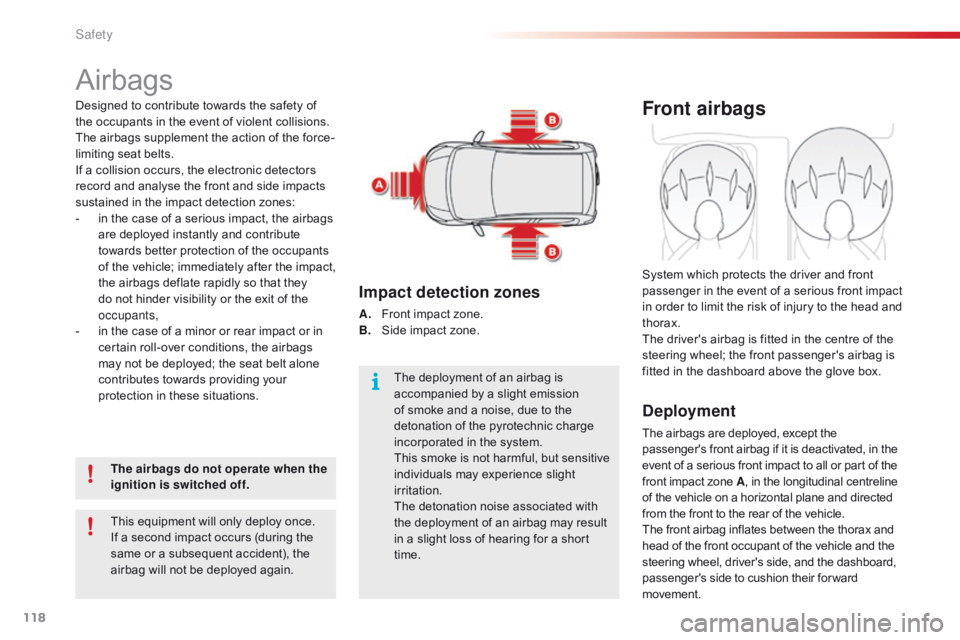
118
C1_en_Chap06_securite_ed01-2016
Airbags
Designed to contribute towards the safety of the occupants in the event of violent collisions.
T
he airbags supplement the action of the force-
limiting
seat belts.
If
a collision occurs, the electronic detectors
r
ecord and analyse the front and side impacts
s
ustained in the impact detection zones:
-
i
n the case of a serious impact, the airbags
a
re deployed instantly and contribute
t
owards better protection of the occupants
o
f the vehicle; immediately after the impact,
t
he airbags deflate rapidly so that they
d
o not hinder visibility or the exit of the
o
ccupants,
-
i
n the case of a minor or rear impact or in
c
ertain roll-over conditions, the airbags
m
ay not be deployed; the seat belt alone
c
ontributes towards providing your
p
rotection in these situations.
The airbags do not operate when the
ignition is switched off. The
deployment of an airbag is
a
ccompanied by a slight emission
o
f smoke and a noise, due to the
d
etonation of the pyrotechnic charge
i
ncorporated in the system.
This
smoke is not harmful, but sensitive
i
ndividuals may experience slight
ir
ritation.
The
detonation noise associated with
t
he deployment of an airbag may result
i
n a slight loss of hearing for a short
t
ime.
This
equipment will only deploy once.
I
f a second impact occurs (during the
s
ame or a subsequent accident), the
a
irbag will not be deployed again.
Impact detection zones
A. Front impact zone.
B. S ide impact zone.
Front airbags
Deployment
The airbags are deployed, except the passenger's front airbag if it is deactivated, in the e
vent of a serious front impact to all or part of the
f
ront impact zone A,
in the longitudinal centreline
o
f the vehicle on a horizontal plane and directed
f
rom the front to the rear of the vehicle.
The
front airbag inflates between the thorax and
h
ead of the front occupant of the vehicle and the
s
teering wheel, driver's side, and the dashboard,
p
assenger's side to cushion their for ward
m
ovement.
System
which protects the driver and front
p
assenger in the event of a serious front impact
i
n order to limit the risk of injury to the head and
t
horax.
The driver's airbag is fitted in the centre of the
s
teering wheel; the front passenger's airbag is
f
itted in the dashboard above the glove box.
Safety
Page 124 of 269
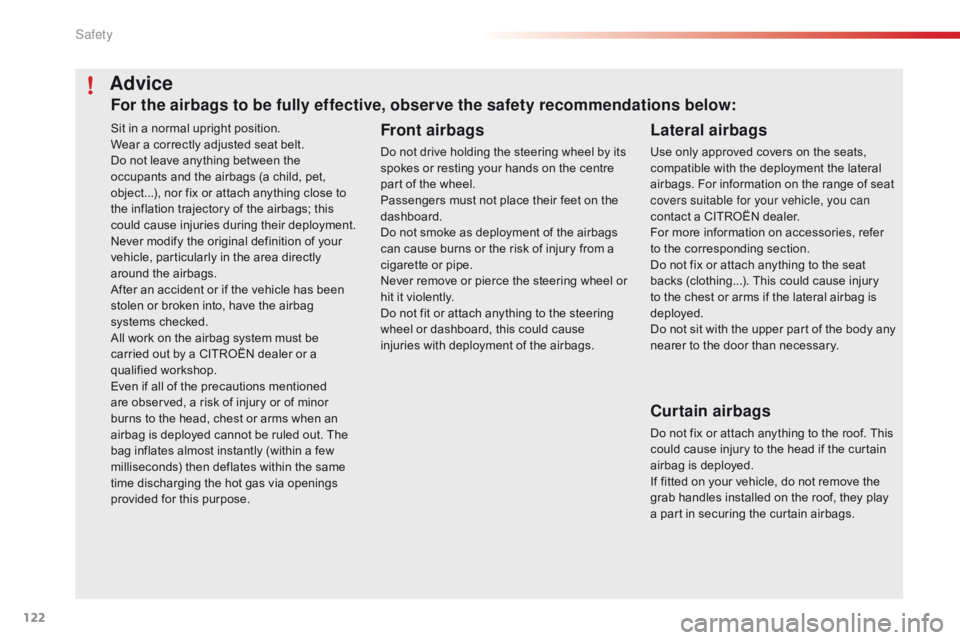
122
C1_en_Chap06_securite_ed01-2016
Sit in a normal upright position.
W ear a correctly adjusted seat belt.
Do
not leave anything between the
o
ccupants and the airbags (a child, pet,
o
bject...), nor fix or attach anything close to
t
he inflation trajectory of the airbags; this
c
ould cause injuries during their deployment.
Never
modify the original definition of your
v
ehicle, particularly in the area directly
a
round the airbags.
After
an accident or if the vehicle has been
s
tolen or broken into, have the airbag
s
ystems checked.
All
work on the airbag system must be
c
arried out by a CITROËN dealer or a
q
ualified
w
orkshop.
Even
if all of the precautions mentioned
a
re observed, a risk of injury or of minor
b
urns to the head, chest or arms when an
a
irbag is deployed cannot be ruled out. The
b
ag inflates almost instantly (within a few
m
illiseconds) then deflates within the same
t
ime discharging the hot gas via openings
p
rovided for this purpose.Front airbags
Do not drive holding the steering wheel by its spokes or resting your hands on the centre
p
art of the wheel.
Passengers
must not place their feet on the
das
hboard.
Do
not smoke as deployment of the airbags
c
an cause burns or the risk of injury from a
c
igarette or pipe.
Never
remove
or
pierce
the
steering
wheel
or
h
it it violently.
Do
not fit or attach anything to the steering
w
heel or dashboard, this could cause
i
njuries with deployment of the airbags.
Advice
Lateral airbags
Use only approved covers on the seats, compatible with the deployment the lateral
a
irbags. For information on the range of seat
c
overs suitable for your vehicle, you can
contact
a CITROËN dealer.
For
more information on accessories, refer
t
o the corresponding section.
Do
not fix or attach anything to the seat
b
acks (clothing...). This could cause injury
t
o the chest or arms if the lateral airbag is
d
eployed.
Do
not sit with the upper part of the body any
n
earer to the door than necessary.
Curtain airbags
Do not fix or attach anything to the roof. This could cause injury to the head if the curtain
a
irbag is deployed.
If
fitted on your vehicle, do not remove the
g
rab handles installed on the roof, they play
a
part in securing the curtain airbags.
For the airbags to be fully effective, observe the safety recommendations below:
Safety
Page 142 of 269
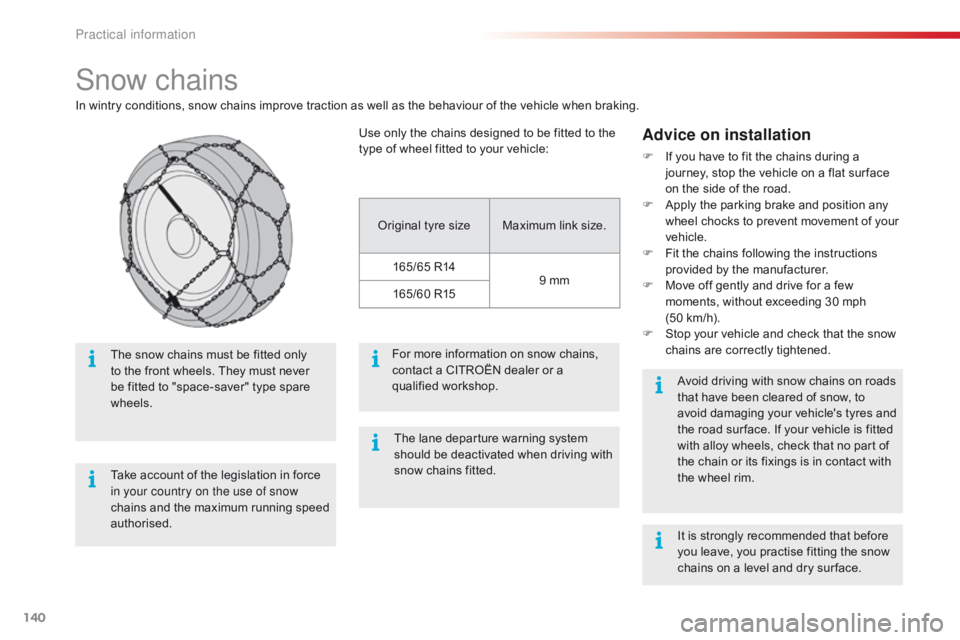
140
C1_en_Chap07_info-pratiques_ed01-2016
Snow chains
In wintry conditions, snow chains improve traction as well as the behaviour of the vehicle when braking.
Advice on installation
F If you have to fit the chains during a j
ourney, stop the vehicle on a flat sur face
o
n the side of the road.
F
A
pply the parking brake and position any
w
heel chocks to prevent movement of your
v
ehicle.
F
F
it the chains following the instructions
p
rovided by the manufacturer.
F
M
ove off gently and drive for a few
m
oments, without exceeding 30 mph
(50
km/h).
F
S
top your vehicle and check that the snow
c
hains are correctly tightened.
Take
account
of
the
legislation
in
force
i
n your country on the use of snow
chains
and
the
maximum
running
speed
a
uthorised.
The
snow
chains
must
be
fitted
only
t
o
the
front
wheels.
They
must
never
b
e
fitted
to
"space-saver"
type
spare
w
heels. Avoid
driving with snow chains on roads
t
hat have been cleared of snow, to
a
void damaging your vehicle's tyres and
t
he road sur face. If your vehicle is fitted
w
ith alloy wheels, check that no part of
t
he chain or its fixings is in contact with
t
he wheel rim.
Use
only
the
chains
designed
to
be
fitted
to
the
t
ype
of
wheel
fitted
to
your
vehicle:
Original
tyre
size Maximum
link
size.
165/65
R14 9
mm
165/60
R15
For
more
information
on
snow
chains,
c
ontact
a
CITROËN
dealer
or
a
q
ualified
w
orkshop. It
is strongly recommended that before
y
ou leave, you practise fitting the snow
c
hains on a level and dry sur face.
The
lane
departure
warning
system
s
hould
be
deactivated
when
driving
with
s
now
chains
fitted.
Practical information
Page 144 of 269
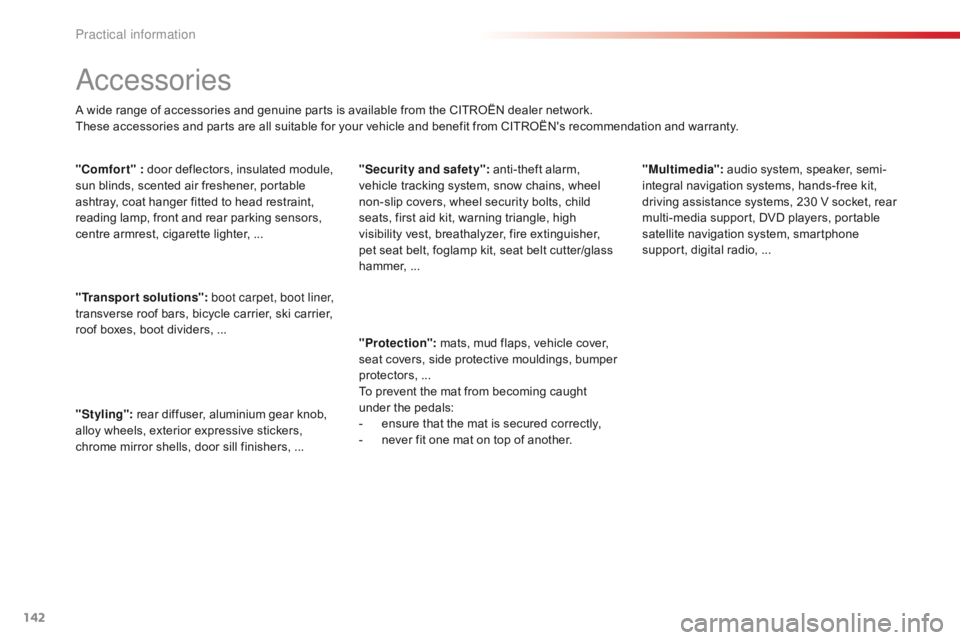
142
C1_en_Chap07_info-pratiques_ed01-2016
Accessories
A wide range of accessories and genuine parts is available from the CITROËN dealer network.
T hese accessories and parts are all suitable for your vehicle and benefit from CITROËN's recommendation and warranty.
"Transport solutions":
boot carpet, boot liner,
transverse
roof bars, bicycle carrier, ski carrier,
r
oof boxes, boot dividers, ...
"Styling":
rear diffuser, aluminium gear knob,
a
lloy wheels, exterior expressive stickers,
c
hrome mirror shells, door sill finishers, ...
"Comfort" :
door deflectors, insulated module,
s
un blinds, scented air freshener, portable
a
shtray, coat hanger fitted to head restraint,
r
eading lamp, front and rear parking sensors,
c
entre armrest, cigarette lighter, ..."Security and safety":
anti-theft alarm,
v
ehicle tracking system, snow chains, wheel
n
on-slip covers, wheel security bolts, child
s
eats, first aid kit, warning triangle, high
v
isibility vest, breathalyzer, fire extinguisher,
p
et seat belt, foglamp kit, seat belt cutter/glass
h
ammer,
...
"
Protection":
mats, mud flaps, vehicle cover,
s
eat covers, side protective mouldings, bumper
p
rotectors,
...
T
o prevent the mat from becoming caught
u
nder the pedals:
-
e
nsure that the mat is secured correctly,
-
n
ever fit one mat on top of another."Multimedia":
audio
system, speaker, semi-
integral
navigation systems, hands-free kit,
d
riving assistance systems, 230 V socket, rear
m
ulti-media support, DVD players, portable
s
atellite navigation system, smartphone
s
upport, digital radio, ...
Practical information
Page 155 of 269
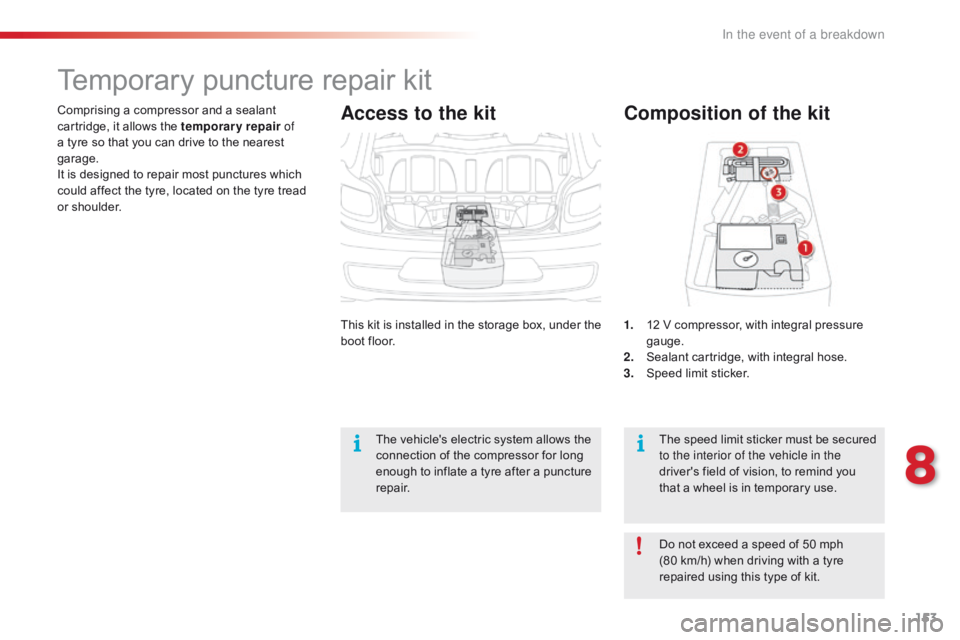
153
C1_en_Chap08_en-cas-pannes_ed01-2016
Comprising a compressor and a sealant cartridge, it allows the temporary repair of
a
tyre so that you can drive to the nearest
g
arage.
It
is designed to repair most punctures which
c
ould affect the tyre, located on the tyre tread
o
r shoulder.
Temporary pu ncture r epair k it
Composition of the kit
1. 12 V compressor, with integral pressure ga
uge.
2.
S
ealant cartridge, with integral hose.
3.
S
peed limit sticker.
The
speed limit sticker must be secured
t
o the interior of the vehicle in the
driver's
field of vision, to remind you
t
hat a wheel is in temporary use.
This
k
it
i
s
i
nstalled
i
n
t
he
s
torage
b
ox,
u
nder
t
he
b
oot
floor.
The
vehicle's
electric
system
allows
the
c
onnection
of
the
compressor
for
long
e
nough
to
inflate
a
tyre
after
a
puncture
r
epair. Do
not exceed a speed of 50 mph
(
80 km/h) when driving with a tyre
r
epaired using this type of kit.
Access to the kit
8
In the event of a breakdown
Page 160 of 269
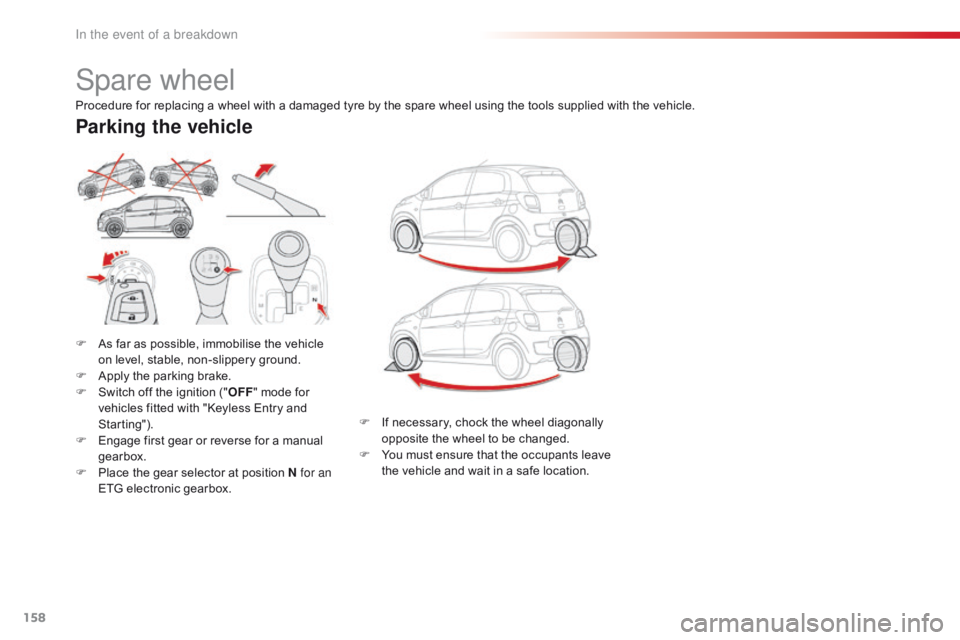
158
C1_en_Chap08_en-cas-pannes_ed01-2016
Spare wheel
F As far as possible, immobilise the vehicle o
n level, stable, non-slippery ground.
F
A
pply the parking brake.
F
S
witch off the ignition ("OFF "
mode for
v
ehicles fitted with "Keyless Entry and
S
tarting").
F
E
ngage first gear or reverse for a manual
g
earbox.
F
P
lace the gear selector at position N for an
ETG
electronic gearbox.
Parking the vehicle
Procedure for replacing a wheel with a damaged tyre by the spare wheel using the tools supplied with the vehicle.
F
I
f necessary, chock the wheel diagonally
o
pposite the wheel to be changed.
F
Y
ou must ensure that the occupants leave
t
he vehicle and wait in a safe location.
In the event of a breakdown
Page 161 of 269
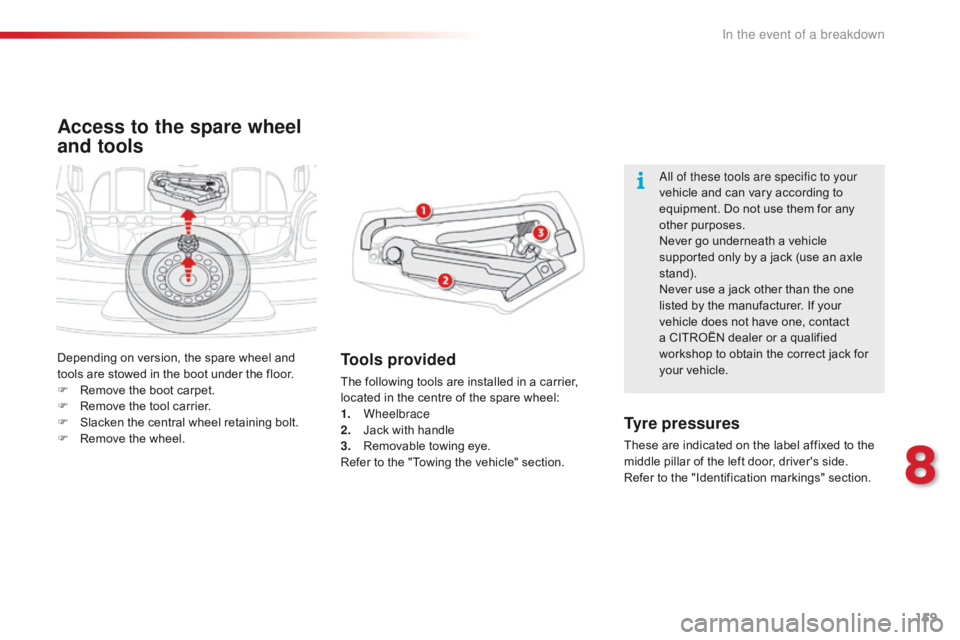
159
C1_en_Chap08_en-cas-pannes_ed01-2016
Access to the spare wheel
and tools
Tools provided
The following tools are installed in a carrier, located in the centre of the spare wheel:
1.
Wheelbrace
2.
J
ack with handle
3.
R
emovable towing eye.
Refer
to the "Towing the vehicle" section.
Tyre pressures
These are indicated on the label affixed to the middle pillar of the left door, driver's side.
Refer
to the "Identification markings" section.
All of these tools are specific to your
vehicle
and can vary according to
e
quipment. Do not use them for any
o
ther
p
urposes.
Never go underneath a vehicle
s
upported only by a jack (use an axle
s
tand).
Never use a jack other than the one
l
isted by the manufacturer. If your
v
ehicle does not have one, contact
a
CITROËN dealer or a qualified
w
orkshop to obtain the correct jack for
y
our vehicle.
Depending
on
version,
the
spare
wheel
and
t
ools
are
stowed
in
the
boot
under
the
floor.
F
R
emove
the
boot
carpet.
F
R
emove
the
tool
carrier.
F
S
lacken
the
central
wheel
retaining
bolt.
F
R
emove
the
wheel.
8
In the event of a breakdown
Page 162 of 269
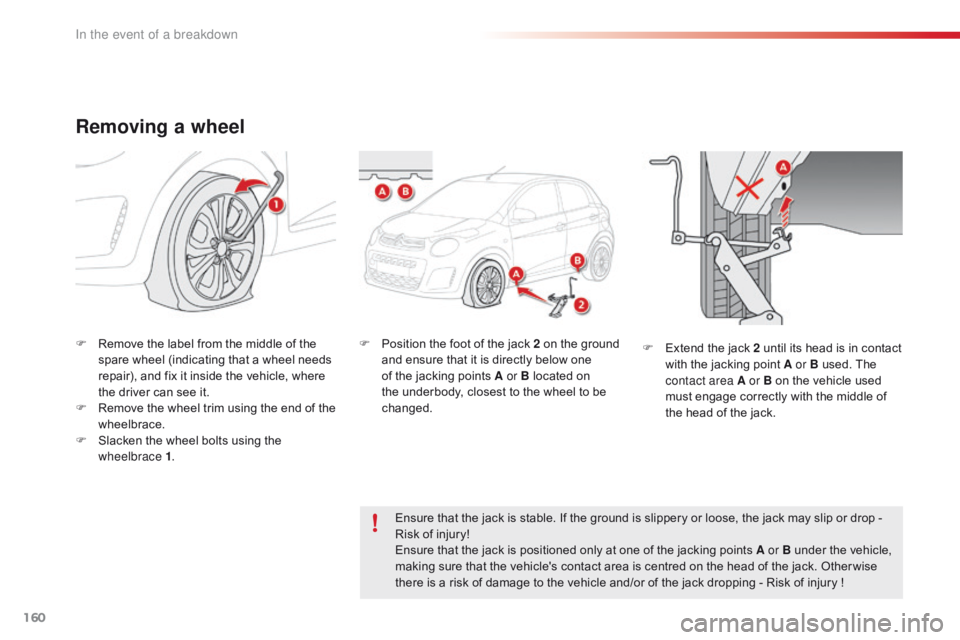
160
C1_en_Chap08_en-cas-pannes_ed01-2016
Removing a wheel
F Remove the label from the middle of the s
pare wheel (indicating that a wheel needs
r
epair), and fix it inside the vehicle, where
t
he driver can see it.
F
R
emove the wheel trim using the end of the
w
heelbrace.
F
S
lacken the wheel bolts using the
w
heelbrace 1 . F
P osition the foot of the jack 2 on the ground a
nd ensure that it is directly below one
o
f the jacking points A or B located on
t
he underbody, closest to the wheel to be
c
hanged.
Ensure
that the jack is stable. If the ground is slippery or loose, the jack may slip or drop -
R
isk of injury!
Ensure
that the jack is positioned only at one of the jacking points A or B under the vehicle,
m
aking sure that the vehicle's contact area is centred on the head of the jack. Other wise
t
here is a risk of damage to the vehicle and/or of the jack dropping - Risk of injury !
F
E xtend the jack 2 until its head is in contact
w
ith the jacking point A or B used. The
c
ontact area A or B on the vehicle used
m
ust engage correctly with the middle of
t
he head of the jack.
In the event of a breakdown
Page 163 of 269
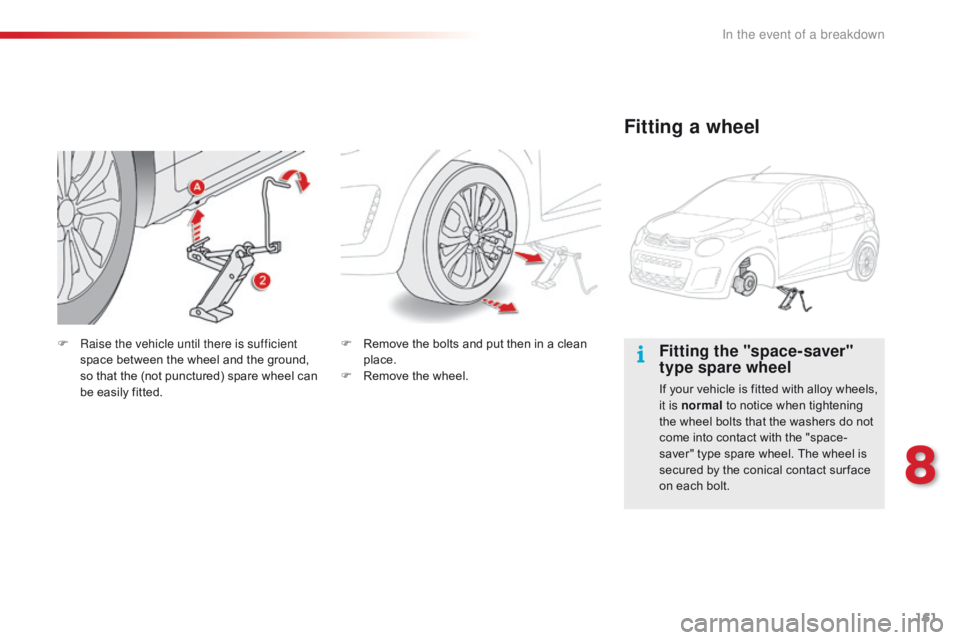
161
C1_en_Chap08_en-cas-pannes_ed01-2016
Fitting the "space-saver"
type spare wheel
If your vehicle is fitted with alloy wheels, it is normal to notice when tightening
t
he wheel bolts that the washers do not
c
ome into contact with the "space-
saver"
type spare wheel. The wheel is
s
ecured by the conical contact sur face
o
n each bolt.
Fitting a wheel
F Remove the bolts and put then in a clean p
lace.
F
R
emove the wheel.
F
Ra
ise the vehicle until there is sufficient
space
between
the
wheel
and
the
ground,
s
o
that
the
(not
punctured)
spare
wheel
can
b
e
easily
fitted.
8
In the event of a breakdown
Page 164 of 269
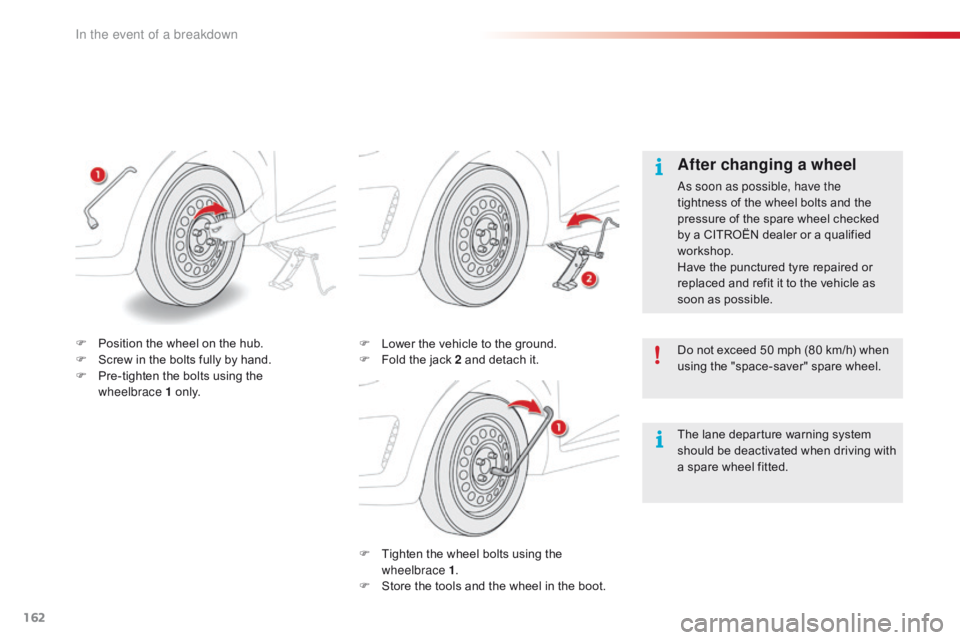
162
C1_en_Chap08_en-cas-pannes_ed01-2016
F Tighten the wheel bolts using the w
heelbrace 1 .
F
S
tore the tools and the wheel in the boot.
F
L
ower the vehicle to the ground.
F
F
old the jack 2 and detach it.
After changing a wheel
As soon as possible, have the
tightness
of the wheel bolts and the
p
ressure of the spare wheel checked
b
y a CITROËN dealer or a qualified
w
orkshop.
Have
the punctured tyre repaired or
r
eplaced and refit it to the vehicle as
s
oon as possible.
Do
not exceed 50 mph (80 km/h) when
u
sing the "space-saver" spare wheel.
F
P
osition
the
wheel
on
the
hub.
F
S
crew
in
the
bolts
fully
by
hand.
F
P
re-tighten
the
bolts
using
the
w
heelbrace
1
o
n l y. The
lane departure warning system
s
hould be deactivated when driving with
a
spare wheel fitted.
In the event of a breakdown